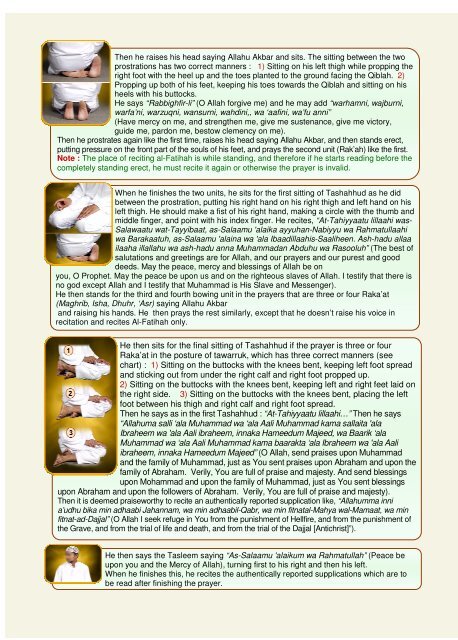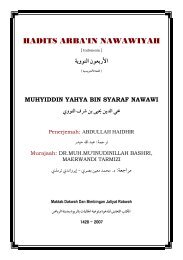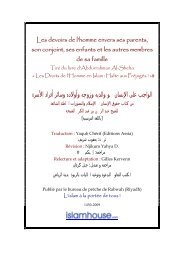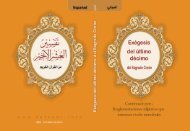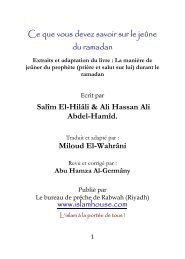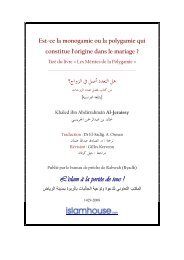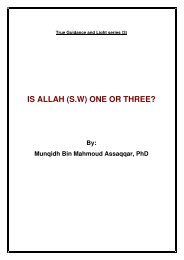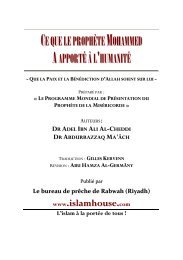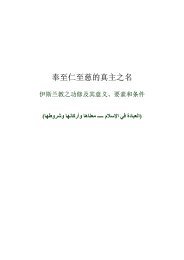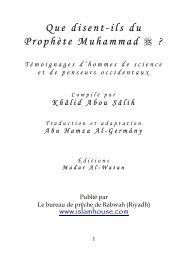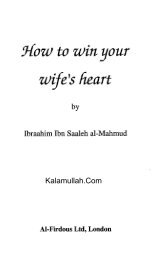are there? - Islam Center
are there? - Islam Center
are there? - Islam Center
You also want an ePaper? Increase the reach of your titles
YUMPU automatically turns print PDFs into web optimized ePapers that Google loves.
Then he raises his head saying Allahu Akbar and sits. The sitting between the two<br />
prostrations has two correct manners : 1) Sitting on his left thigh while propping the<br />
right foot with the heel up and the toes planted to the ground facing the Qiblah. 2)<br />
Propping up both of his feet, keeping his toes towards the Qiblah and sitting on his <br />
heels with his buttocks.<br />
He says “Rabbighfir-li” (O Allah forgive me) and he may add “warhamni, wajburni,<br />
<br />
warfa’ni, warzuqni, wansurni, wahdini,, wa ‘aafini, wa’fu anni”<br />
(Have mercy on me, and strengthen me, give me sustenance, give me victory,<br />
guide me, pardon me, bestow clemency on me).<br />
Then he prostrates again like the first time, raises his head saying Allahu Akbar, and then stands erect, <br />
putting pressure on the front part of the souls of his feet, and prays the second unit (Rak’ah) like the first.<br />
Note : The place of reciting al-Fatihah is while standing, and <strong>there</strong>fore if he starts reading before the<br />
completely standing erect, he must recite it again or otherwise the prayer is invalid.<br />
<br />
<br />
When he finishes the two units, he sits for the first sitting of Tashahhud as he did<br />
between the prostration, putting his right hand on his right thigh and left hand on his<br />
<br />
left thigh. He should make a fist of his right hand, making a circle with the thumb and<br />
middle finger, and point with his index finger. He recites, “At-Tahiyyaatu lillaahi was-<br />
Salawaatu wat-Tayyibaat, as-Salaamu 'alaika ayyuhan-Nabiyyu wa Rahmatullaahi<br />
<br />
wa Barakaatuh, as-Salaamu 'alaina wa 'ala Ibaadillaahis-Saaliheen. Ash-hadu allaa<br />
ilaaha illallahu wa ash-hadu anna Muhammadan Abduhu wa Rasooluh” (The best of<br />
salutations and greetings <strong>are</strong> for Allah, and our prayers and our purest and good<br />
deeds. May the peace, mercy and blessings of Allah be on <br />
you, O Prophet. May the peace be upon us and on the righteous slaves of Allah. I testify that <strong>there</strong> is<br />
no god except Allah and I testify that Muhammad is His Slave and Messenger).<br />
He then stands for the third and fourth bowing unit in the prayers that <strong>are</strong> three or four Raka’at<br />
<br />
(Maghrib, Isha, Dhuhr, ‘Asr) saying Allahu Akbar<br />
and raising his hands. He then prays the rest similarly, except that he doesn’t raise his voice in<br />
recitation and recites Al-Fatihah only.<br />
He then sits for the final sitting of Tashahhud if the prayer is three or four<br />
Raka’at in the posture of tawarruk, which has three correct manners (see<br />
chart) : 1) Sitting on the buttocks with the knees bent, keeping left foot spread<br />
and sticking out from under the right calf and right foot propped up.<br />
2) Sitting on the buttocks with the knees bent, keeping left and right feet laid on<br />
the right side. 3) Sitting on the buttocks with the knees bent, placing the left<br />
foot between his thigh and right calf and right foot spread.<br />
Then he says as in the first Tashahhud : “At-Tahiyyaatu lillaahi…” Then he says<br />
“Allahuma salli ‘ala Muhammad wa ‘ala Aali Muhammad kama sallaita 'ala<br />
Ibraheem wa 'ala Aali ibraheem, innaka Hameedum Majeed, wa Baarik ‘ala<br />
Muhammad wa ‘ala Aali Muhammad kama baarakta ‘ala Ibraheem wa 'ala Aali<br />
ibraheem, innaka Hameedum Majeed” (O Allah, send praises upon Muhammad<br />
and the family of Muhammad, just as You sent praises upon Abraham and upon the<br />
family of Abraham. Verily, You <strong>are</strong> full of praise and majesty. And send blessings<br />
upon Mohammad and upon the family of Muhammad, just as You sent blessings<br />
upon Abraham and upon the followers of Abraham. Verily, You <strong>are</strong> full of praise and majesty).<br />
Then it is deemed praiseworthy to recite an authentically reported supplication like, “Allahumma inni<br />
a’udhu bika min adhaabi Jahannam, wa min adhaabil-Qabr, wa min fitnatal-Mahya wal-Mamaat, wa min<br />
fitnat-ad-Dajjal” (O Allah I seek refuge in You from the punishment of Hellfire, and from the punishment of<br />
the Grave, and from the trial of life and death, and from the trial of the Dajjal [Antichrist]”). <br />
He then says the Tasleem saying “As-Salaamu 'alaikum wa Rahmatullah” (Peace be<br />
upon you and the Mercy of Allah), turning first to his right and then his left.<br />
When he finishes this, he recites the authentically reported supplications which <strong>are</strong> to<br />
be read after finishing the prayer.


